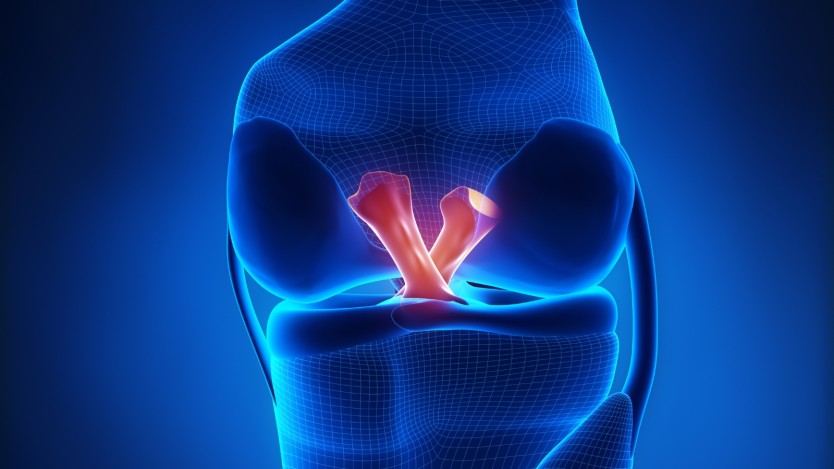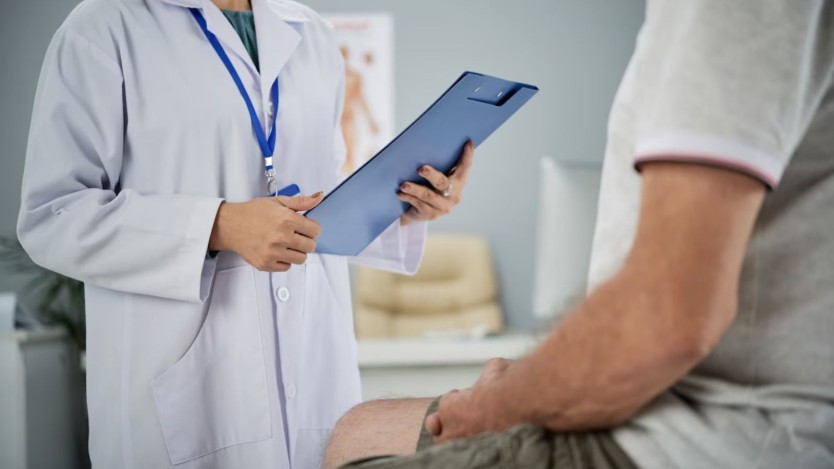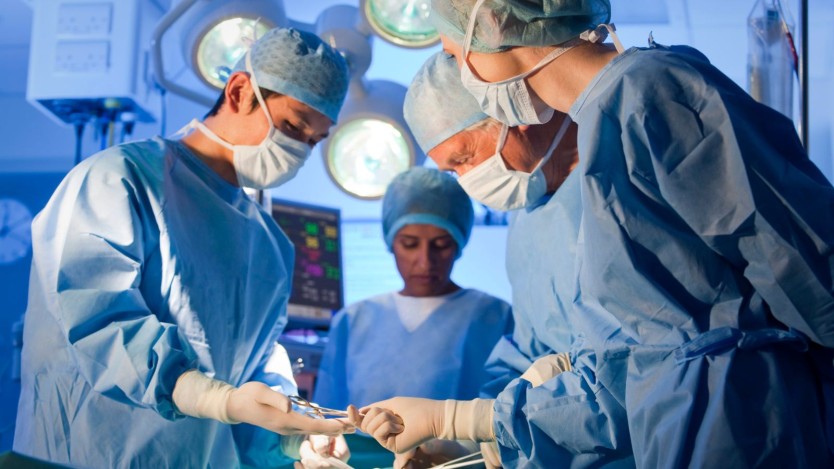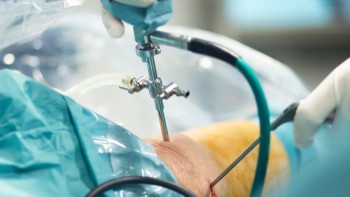Symptoms of Anterior Cruciate Ligament Tear

- What is the function of cruciate ligaments?
- How do cruciate ligament injuries occur?
- What are the signs and symptoms of anterior cruciate ligament tear?
- How is an anterior cruciate ligament rupture diagnosed?
- How is an ACL tear treated?
If you ever feel discomfort in your knee, such as instability or even a sensation that it is not resting on the ground, as if it is dislocated, and this is coupled with difficulty in supporting the injured leg, swelling and pain, it is possible that you have torn your ACL as these are common symptoms of this injury.

Do you need cruciate ligaments surgery?
Request a free and immediate appointment with our specialists in Traumatology
If you find it difficult to bend and straighten your knee, you may also have a meniscus injury, so it is important to see a doctor for an assessment.
- The anterior cruciate ligament is one of the most commonly injured ligaments in the knee, especially in elite athletes.
- The symptoms of the patient with an ACL tear will depend on the degree of injury, the greater the degree of injury, the greater the symptoms.
- To treat anterior cruciate ligament rupture, conservative treatment or surgical treatment can be carried out, depending on the characteristics of the patient.
What is the function of cruciate ligaments?

The cruciate ligaments of the knee are two ligamentous structures located within the joint.
The anterior cruciate ligament is the most susceptible to injury.
Its main function is to join the femur and the tibia, especially in the anteroposterior direction of one bone over the other.
These two structures are:
- The anterior cruciate ligament (ACL): joins the back of the femur to the outside of the tibia, passing behind the patella. It also crosses in front of the posterior cruciate ligament.
- The posterior cruciate ligament (PCL): runs in the opposite direction to the ACL, running from the front of the femur to the posterior region of the tibia.
How do cruciate ligament injuries occur?
The anterior cruciate ligament (ACL) is one of the most frequently injured ligaments, as we have already mentioned, making it a much-feared injury for elite athletes. The main reason for this is that surgery is required to repair it, as well as a relatively long period of time for the patient to make a full recovery. The cruciate ligaments are essential for the correct functioning of the knee, so the injury should be treated as soon as possible.
It is common for the anterior cruciate ligament to be injured due to knee sprains, caused by playing a sport that involves twisting with the foot resting on the ground, such as football, basketball, handball, skiing, etc.
It can also be injured due to abrupt foot contact with the ground in sports such as judo, etc.

Other ways in which anterior cruciate ligament rupture can occur include: when an abrupt change in the direction of the knee is made when decelerating abruptly (an example could be when jumping and falling with a bad support of the limb), when stopping abruptly (after running, for example), when running and changing direction abruptly (e.g. when someone runs at a high speed and suddenly makes a lateral turn abruptly changing direction, which causes an abrupt change in the direction of the knee, when someone runs at high speed and suddenly makes a sharp sideways turn and changes direction, causing the foot to dig into the ground and the body to rotate with the knee, resulting in an anterior cruciate ligament rupture).
Anterior cruciate ligament rupture tends to occur more in women than in men, mainly due to anatomical characteristics, such as greater joint laxity, a wider pelvis, which leads to external rotation of the tibia, as well as the location of the anterior cruciate ligament in the knee (called the notch), which is smaller than in men.
In most cases, there are complete ligament tears, which lose their function of stabilising the knee in certain movements. Ruptures of the anterior cruciate ligament are sometimes accompanied by injuries to the internal lateral ligament, but are almost always sprains without complete rupture, meniscal injuries and bone bruises on the outside of the femur and tibia.

Do you need cruciate ligaments surgery?
Request a free and immediate appointment with our specialists in Traumatology
What are the signs and symptoms of anterior cruciate ligament tear?
The main symptom is the intense pain that the patient feels in the knee, which makes them unable to continue with the exercise they were doing, as well as giving them great insecurity when walking, as it can happen that the knee bends involuntarily.
Occasionally, the patient may hear a kind of cracking sound or feel as if something is breaking inside, in addition to the subsequent swelling of the knee and the sudden pain.

Sometimes, especially when swelling and joint effusion occur, the doctor must puncture the patient to remove the accumulated fluid, which in this case will be mostly blood. What should be done at first is to immobilise the knee, apply cold to reduce the inflammation, take some analgesic or anti-inflammatory medication and, above all, rest.
The intensity of the symptoms will depend on the degree of severity of the injury. There are different degrees of ACL injury:
- Grade 1 sprain: this is a mild injury. In this case, although the ligament is affected, it can maintain its function of stabilising the knee.
- Grade 2 sprain: in this case, the ligament is partially torn.
- Grade 3 sprain: in this case, the ligament is completely torn, causing destabilisation of the knee.
Grade two tears, i.e. partial tears, are infrequent, with grade three injuries, i.e. complete ACL tears, being more common.
When the anterior cruciate ligament is torn, the knee is unstable, as mentioned above.
This instability is one of the most important symptoms of anterior cruciate ligament rupture.
The patient has the sensation of the knee "popping out". This instability can occur during sports and even in activities of daily living. In addition, it can cause pain and swelling for the patient and can increase premature wear and tear on the knee.
Another problem that can cause a torn anterior cruciate ligament is a torn meniscus. As the knee is destabilised, the meniscus will take over the role of the ligaments to give stability to the knee, which can cause the meniscus to tear, as it is not designed for that purpose. They can remove cushioning from the knee, increasing loads and leading to premature wear and tear.
How is an anterior cruciate ligament rupture diagnosed?
To check the stability of the patient's knee, the specialist can perform several tests, which are discussed below:
Anterior drawer test
This is the most common test to identify an anterior cruciate ligament injury. It consists of the following: the patient is positioned lying upwards with the knee and hip flexed and the foot resting on the examination table with neutral rotation.
To perform the examination, the specialist shall place both thumbs on the anterior surface of the tibia at its cephalic extremity and the rest of the fingers in the popliteal fossa.
The specialist should pull the tibia forward, noting whether it slides under the femur. If a hard stop is produced at the end of the manoeuvre, it means that the ligament is not damaged; on the contrary, if a soft stop is produced without resistance, there is injury to the anterior cruciate ligament.
If this test demonstrates injury, the specialist may subsequently perform two further tests to identify joint capsule lesions:
- Anterior drawer test in external rotation: this is the same as the previous one, but is performed with a 30° rotation of the tibia, which will demonstrate the existence of the ACL tear and the posterointernal point of the capsule.
- Anterior drawer test in internal rotation: this is the same as the previous two tests, but in this case, the tibia is in internal rotation, so that the anterior cruciate ligament injury and the point of the posteroexternal angle of the capsule can be identified.
Lachman test
This test consists of the patient lying supine (face up) with the leg relaxed and the knee flexed to 20°. The doctor holds the distal end with one hand and the proximal end of the tibia at the level of the popliteal fossa with the other hand.
With the latter hand, the specialist pushes forward and, if resistance is encountered, it means that the ligament is completely or partially torn; on the other hand, if no resistance is encountered, it means that the ligament is completely torn.
This test is performed in a prone position (the patient is placed lying down with the head on the side) in case the specialist has very small hands or the patient has very bulky legs. The patient flexes the knee to 30° and the specialist places both hands on the cranial portion of the tibia with the thumbs on the popliteal fossa and the other fingers on the anterior aspect. In this case the test result is the same as in the previous case.

Jerk test
The patient is placed in the supine position (lying flat on the back) with the hip flexed 45° and the knee flexed 90°. The specialist grasps the foot and performs an internal rotation, while the other hand is held on the outside of the proximal end of the tibia and fibula.
The knee is extended while the physician deflects the leg outward while maintaining the rotation. The test is positive if there is forward displacement of the joint over the femur at 30°, which disappears when knee extension is complete.
Pivot Shift Manoeuvre
Performed in the same way as above, but in reverse, i.e. from extension to flexion.
External rotation recurvatum test
The patient is placed in the supine decubitus position (lying upwards) with the legs extended and relaxed. The specialist takes the patient by the big toes and, lifting the legs, compares the two legs, paying particular attention to the prominence of the bones. If the specialist observes an excess of recurvatum (hyperextension position of the knee) in either leg, this reflects a deficiency in the ACL.
Slocum Manoeuvre
This test is used to demonstrate ACL instability. The patient is placed in lateral decubitus (lying on one side) opposite the leg to be examined with the knee flexed 20°. One of the specialist's hands fixes the distal epiphysis of the femur (one end of the bone is called the epiphysis) and the other grasps the tibial mass (the upper extremity of the tibia). The doctor moves his/her thumb gently forward and, if he/she finds a bump or the presence of pain, the manoeuvre is considered positive.
Magnetic resonance imaging
This is performed to confirm the appearance of the ligament and to assess other meniscal or upper cartilage lesions.

Do you need cruciate ligaments surgery?
Request a free and immediate appointment with our specialists in Traumatology
How is an ACL tear treated?
Conservative treatment
If the patient is not a regular athlete, i.e. has a rather sedentary lifestyle and is over 35 years of age, and if there are no other injuries (meniscus, cartilage or bone), conservative treatment may be an option, since the ACL tear does not cause pain to the patient and allows recovery in a few weeks.
The patient's leg should be strengthened through rehabilitation, and he/she should also avoid sports that could endanger the recovery of the injury, such as those that require turning movements or sudden braking.
Some of these sports are: football, basketball, handball, skiing, judo, motocross, etc. In short, it can be said that a patient can recover from an ACL injury without undergoing surgery, which will not prevent him/her from leading a normal life.
Conservative treatment consists of the following:
- Complete rest.
- Application of ice for the first 3 days (between 10 and 15 minutes every two hours).
- Placement of a bandage to compress the knee.
- Keep the leg elevated above the heart.
- Use walking aids as far as possible (crutch or cane) during the first week.
- Perform rehabilitation exercises to strengthen the muscles around the knee.
Surgical treatment
In the case of young, active patients, the treatment to repair an ACL injury is surgical, which consists of reconstruction of the anterior cruciate ligament. The technique used is arthroscopy.
The ligament is repaired by grafting the patient's own tendons (autograft) or with tendons from a donor (allograft). Tendons from the hamstring (hamstring) or the central third of the patellar tendon may be used. If the graft is from a bone bank, patellar tendon (HTH) or Achilles tendon is often used as well.
Patients operated on with this type of graft recover faster, as the graft does not have to be taken from any of the patient's own areas, which can cause pain or inflammation in the first few weeks.

One of the disadvantages is the limited availability of grafts in the banks, and another disadvantage may be the transmission of a viral disease, although this is very difficult, due to the control to which the tissues are subjected.
The most important thing is the correct placement of the new ligament, as the different grafts can be placed in different ways, both in the femur and in the tibia: by means of interference screws, staples, cross pins, suspension systems, etc.
The important thing is to have an experienced surgeon, as it will be he who will decide, depending on the case of each patient, which one to use.
The surgery lasts approximately one hour and is performed under spinal anaesthesia (by pricking the patient in the back). After surgery, the patient usually spends one night in hospital and can go home the next day, but with crutches and an articulated knee brace, which must be worn locked in extension for two weeks.
The patient will be able to support the leg for the first time if there are no concomitant cartilage lesions. The stitches will be removed in about 10 days, so it is advisable to start rehabilitation of the knee after the stitches are removed.
Rehabilitation should last as long as necessary to achieve the desired activity.
Possible complications after surgery
Some of the most common complications of surgery are joint stiffness, infection and thromboembolism.
As for the return to daily activities, it is not advisable to run before 3-4 months and risky sports after 6 months. It should be noted that, until one year after the operation, the graft is not fully integrated and does not have the same tension as the original ligament.
As for the results, they are similar with the different techniques.
Finally, with regard to the complications that may occur, there is a small percentage of cases in which an operation must be carried out to revise the knee, especially when there is pain, lack of full extension, discomfort, etc. In the event of a tear in the new ligament, the operation must be performed again, with the specialist assessing the cause, etc.

Do you need cruciate ligaments surgery?
Request a free and immediate appointment with our specialists in Traumatology
Medical disclaimer: All the published content in Operarme is intended to disseminate reliable medical information to the general public, and is reviewed by healthcare professionals. In any case should this information be used to perform a diagnosis, indicate a treatment, or replace the medical assessment of a professional in a face to face consultation. Find more information in the links below:



